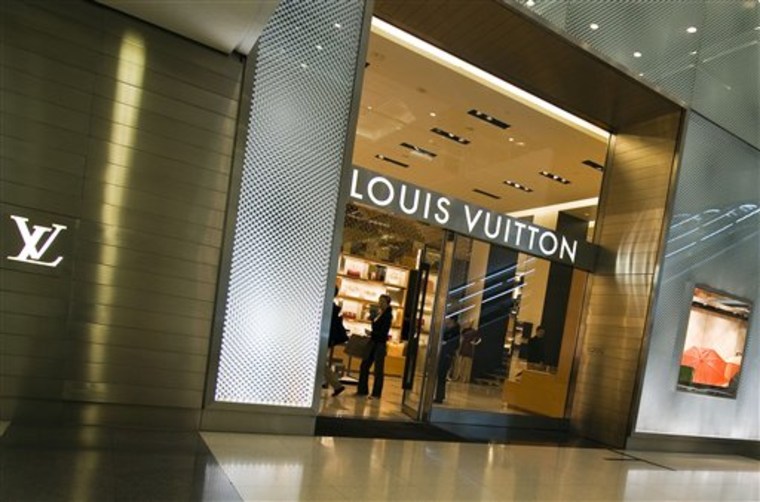Clutching a fistful of shopping bags from designers Vivienne Westwood, Dior and Alexander McQueen as she concluded one of her twice-monthly shopping sprees, 29-year-old Zhao Bing looked like the picture of hope for luxury retail.
"Is there a financial crisis in China? I don't think it has affected my life very much," said Zhao, who spent 7,000 yuan ($1,000) in 90 minutes at upscale Lane Crawford in Beijing's financial district last week. "I still buy those big brands, anyone you could think of."
Many well-heeled Chinese shoppers like Zhao, a film technician who gets an allowance from her parents on top of her salary, are spending freely during the global economic crisis. High-end designers and luxury retailers that thrive on such extravagance hope China's growing luxury-seeking population will cushion them against the collapse in demand in other countries.
China's 6 billion euro ($8 billion) luxury market accounts for just 3 percent of global sales, compared with 38 percent in Europe, 33 percent in South and North America and 12 percent in Japan, according to Bain & Co. But China and Brazil are projected to be the two fastest-growing luxury markets through 2012, according to consulting firm Bain & Co.
And sales of designer clothing, jewelry and other luxury goods in China will climb 7 percent this year, while worldwide luxury revenue could fall 10 percent, Bain & Co. forecast. Last year, luxury sales surged 25 percent in China while they were flat worldwide.
Just as more mainstream brands like Starbucks Corp. and Yum Brands Inc.'s KFC are expanding fast in China, higher-end brands such as Salvatore Ferragamo and Gucci are adding stores here — while many retailers have postponed or limited expansion in listless U.S., European and Japanese markets.
"The China market is growing fast. Beside the global downturn, which affects every country, China is quite stable," Michele Norsa, chief executive of Salvatore Ferragamo SpA, said in an e-mail response to questions. "Definitively, we are optimistic."
Ferragamo plans to add seven to eight China stores this year, with further expansion in 2010, according to Norsa.
Gucci Group, part of France's PPR SA, plans to open a flagship store in Shanghai in May after adding three new locations in January. It says its sales in China soared 42 percent last year compared with 2007, 10 times its global growth rate of 4.2 percent. Gucci said China currently represents one of its most dynamic areas of retail growth. Greater China including Hong Kong and Macau accounted for 14.3 percent of Gucci's sales last year.
France's Domaines Barons de Rothschild, producer of Chateau Lafite wine, is developing a vineyard in the eastern province of Shandong to serve growing local demand.
China's luxury shoppers are strikingly young, many of them self-employed or part of a growing professional class. According to consulting firm McKinsey & Co., 80 percent are under 45, compared with 30 percent of luxury shoppers in the United States and 19 percent in Japan.
Liu Hongyan, a 34-year-old marketing director for a culture magazine in the western city of Chengdu, just bought a Coach purse to replace her Chanel, two necklaces and a bracelet from Tiffany and some Estee Lauder cosmetics.
"Like many of my friends, my job is stable and not affected by the financial crisis," she said. "Now that we are finished buying apartments and cars, we are buying luxury goods."
Companies with a big presence in China, including Hermes Group and LVMH Group, declined interview requests. Spokespeople for Giorgio Armani SpA and Swatch Group said managers had no time to talk. Tiffany & Co. and Burberry Group did not respond to calls.
Growth in China may not be huge in dollar terms, but it helps counter sales declines elsewhere, says Claudia D'Arpizio, a Bain partner in Milan.
"It's not enough for offsetting completely the stronger decrease in the U.S., Japan and Europe," she said.
Fueled by a three-decade-old economic boom that created a still-growing urban elite, China's appetite for luxury goods is surviving the sharpest global economic slump since the 1930s. And Beijing's multibillion-dollar stimulus plan appears to be reviving the economy. Recent reports show gains in factory output, retail sales and capital investment.
By 2015, China will have more than 4 million households with annual income above 250,000 yuan ($37,000), McKinsey predicted in a recent report. That will make it the world's fourth-largest country in terms of its number of households with substantial purchasing power after the United States, Japan and the United Kingdom. McKinsey said the benchmark was adjusted for purchasing power parity for each country.
And most of that money likely will be spent in China. McKinsey said its research found wealthy Chinese do 70 percent of their luxury spending at home, contrary to the industry wisdom that Chinese people make at least half their purchases abroad.
"We know Chinese consumers will continue to spend on luxury items," said Ferragamo's Norsa. "After all, it is a very big pond and in it there is space for many."
Companies are expanding inland to cities like Chengdu to reach customers "who can already afford and who will aspire to the image projected by luxury brands," said Bain's D'Arpizio.
Most Chinese, of course, still can't afford luxury brands and opt for knockoffs. From fake Gucci wallets to Chanel bags, they are widely available despite repeated government crackdowns. Some are so well made that only experts can distinguish them from genuine designer goods.
Wu Yang, a 25-year-old Beijing event planner who bought counterfeit Louis Vuitton and Gucci bags on a recent trip to Shanghai, said vendors wanted 300-500 yuan ($45-75) for a bag, compared with 5,000-10,000 ($750-$1,500) for the real thing.
"I can afford it and nobody can tell it's not real," Wu said. "This represents a girl's dream for big brands."
Her next goal: The latest counterfeit Balenciaga bag.
